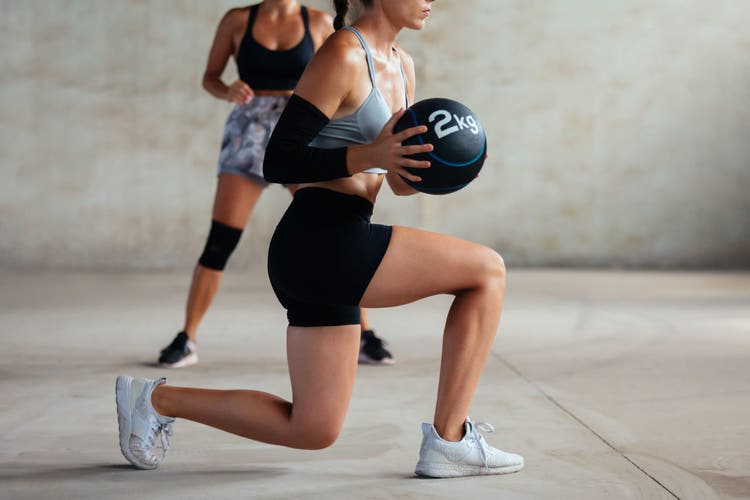Four Moves to Train the Inner Thighs

Have you ever wanted to target specific areas of your body? How about the inner thighs (which are technically called your adductor muscles)? When someone wants to work their inner thighs, oftentimes you’ll see them lying on their side lifting their leg off the ground or using a machine that requires them to squeeze their legs together.
I hate to break it to you, but here’s some insight from a longtime personal trainer: These movements only create the perception that your inner thighs are working—they don’t use the adductors the way they are designed to work when we walk or run. The good news is that it is possible to improve the strength and shape of your adductor muscles. But first, you need to have a good understanding of how they actually work.
How the inner thighs/adductors work
Here are a few things you should know about how your inner thighs are actually designed to work.
- Traditional anatomy often teaches that muscles work as individual units to move only one joint at a time. However, a number of muscles must work together to produce coordinated human movement. Gait, which happens during walking or running, is an excellent example of how a number of muscles work together to create one seemingly simple pattern. The alignment of the muscles and skeletal structures in the body are structured in such a way to help make gait as efficient and effective as possible. If you can identify what a muscle does to move the body during gait, then you can identify the most effective movements for that muscle.
- The adductor muscles of the inner thigh are one of the most misunderstood muscle groups in the human body. If we need to understand how muscles work to help us walk, do we consciously bring our thighs closer to the midline of the body every time we take a step? No, we don’t.
- In two-dimensional images in an anatomy book, it can be challenging to see how the muscles attach to the thighbone (femur). The adductors attach at the back of the bone. As a result, when the thigh is in front of the body, the adductors are lengthened and will pull the thigh backward when the muscles shorten. Likewise, when the thigh is behind the body, the adductors are lengthened and will pull the thigh forward as the muscles contract.
- During the gait cycle, when the right leg is forward, the adductors of the right leg are lengthened. When the left leg is extended behind the body, the left adductors are lengthened. From this position, the adductors on the right leg will move the leg behind the body, and the adductors on the left leg will swing it forward. This happens with every step—the adductors attach between the bottom of the pelvis and the back of the thigh, and they function most effectively to move the thighs (and legs) forward and back, NOT side to side. That’s why the most effective movement to engage and strengthen the adductor muscles involve creating hip flexion and extension.
If you want to successfully target your inner-thigh muscles, consider adding these moves to your next leg workout.
Standing Hip Hinge
- Stand with your feet hip-width apart. Keep your knees slightly bent and spine long with your hands behind your head.
- Push your hips back as you lower your chest toward the ground. Only go until you feel your spine start to round, then push your feet into the ground and press your hips forward to return to standing.
- Keep your shoulders back. Repeat.
Complete two to three sets of 10 to 12 repetitions, resting 30 to 45 seconds between sets. For an additional challenge, hold on to a medicine ball or pair of dumbbells.
Step-Up
- Use a box (or step) about the same height as your kneecap.
- Place your right foot on top of the box, and press your right foot into the box as you pull your body up to the top of the box.
- At the top, balance on your right foot (holding your left leg in the air) for three to five seconds before lowering yourself back to the ground. Repeat.
Complete eight to 12 repetitions on your right leg, then switch legs. Rest 30 to 45 seconds after both legs. Complete two to three sets total. For an additional challenge, hold a dumbbell in each hand.
Rear Lunge
- Stand with your feet hip-width apart.
- With your right foot, step directly backward and slowly lower your right knee toward the floor. (Do not let it hit the floor.)
- Then push your left foot into the ground to pull yourself up as you swing your right leg forward back to start. Repeat.
Complete eight to 12 repetitions on your right leg before switching legs. Rest 30 to 45 seconds after both legs. Complete two to three sets total. For an additional challenge, hold a dumbbell in each hand.
Rotational Lunge
- Stand with your feet hip-width apart.
- Keep your left foot pressed into the ground as you pick up your right foot and rotate it to place it back in the 4 o’clock direction. (Contract the muscles of your left thigh as you do this to create additional stability for your left knee.)
- To return to the starting position, press your left foot into the ground as you push off with your right. (Use the muscles of your left inner thigh to help you return to the starting position.) Repeat.
Complete six to 10 repetitions on your right leg before switching legs. Rest 45 to 60 seconds after both legs. Complete two to three sets total. For an additional challenge, hold a dumbbell in each hand.
Once you start doing these movements, you should feel the difference in your thighs right away. You’re welcome!
Photo credit: BonninStudio, Stocksy